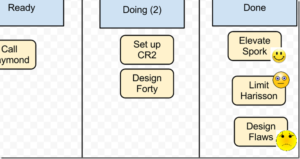This is Week 13 of a Year of Living Productively
This week I tested whether Personal Kanban could improve my productivity. I used the traditional method of Post-It notes and a dry erase board. Scroll to the end of last week’s post for more details.
How Personal Kanban Saved My Sanity This Week
- Helped me visualize my work. I’ve learned that I benefit from having an offline picture of my work in as big a format as possible. I decided to use my large vanity mirror for my Backlog color-coded notes. I could scan them and choose the ones I wanted to work on by category. I also discovered that I have a LOT of blog-related tasks.
- Gave me a reward for completing tasks. It’s a good feeling to move those sticky notes across the board and into the Done column. I was motivated to remove as many sticky notes from my mirror as possible (my teenage son thought I was really weird).
- Was portable. No, I did not put my dry erase board in my purse. But when I knew I would be at the dentist’s office with my laptop for three hours, I quickly pulled the sticky notes I knew I could work on, added them to a piece of paper, and popped them into my laptop bag.
How Personal Kanban Made Me Crazy This Week
- Sticky notes not so sticky. I did have to restick them quite often when they fell off the board. It wasn’t a deal breaker. I did read about people who used magnetic cards instead. I would have to have dozens and dozens of magnets!
- Didn’t limit my work. One of the main reasons I was excited about Kanban (besides visualizing my work) was to force me to limit the amount of work I took on. The problem is there aren’t any limits on the work being fed into the system, only on the tasks being worked concurrently. I’ve discovered that isn’t an issue for me. I don’t tend to flit from thing to thing when I’m actually working on them.
- Work is never complete. Routines, Do it Tomorrow, and Scheduling tasks all gave me a sense of completion at the end of the day. With Kanban there is a never-ending stream of work coming into the system through Backlog. I started to feel hopeless. Then again, maybe it’s the winter that refuses to end!
Did Personal Kanban Help Me Get More Done?
Yes. For the better part of the week, I was motivated to complete as many tasks as possible. It was when I realized I would never finish them all, that the approach broke down for me.
While I don’t want to continue using Personal Kanban, I see a lot of value in having a visual representation of work. Using it to track projects could be very beneficial. I’ve created forms I use for blogging that use checklists for every phase of a post that remind me of Kanban.
A friend sent me a picture of her Kanban board and thanked me for the idea. In no way would I want to discourage anyone from using an approach that works for them. That’s the point of this series! I’m finding what works for me and hopefully you are, too.
**UPDATE**
Although I do not use Personal Kanban for all my tasks, I use it for writing curriculum. I have a large dry erase board at my desk. I have columns of tasks that have to be completed for each lesson (some of which others on my team have to do). I find it motivates me, organizes me, and gives me great peace of mind. Highly recommended for work that goes through a process.
The Productivity Approach I’ll Be Using for Week 14
This week I’ll be using Eat That Frog by Brian Tracy.
The concept. Brian Tracy argues that having a written list of tasks to do the next day will increase productivity by 25%. Furthermore, choosing the top 20% of tasks that make the most difference in your day, work, or life allows you to get the most results for your efforts. Brian says that most people do easy tasks to try and “warm up” to the day, in essence wasting valuable time.
Eating a live frog first thing in the morning is the analogy for choosing to do the worst task first. The work may be repulsive to you because it’s a big, time-consuming task or is just something you don’t want to do. But to be a “frog,” it must be the most important thing you could do that day. Once that frog is “eaten,” you can continue to work your list by identifying the next most important task. This way of working is not only supposed to improve your self-control, but will increase productivity by 50%.
I’m one who has really resisted eating the frog first thing. I read this Pick the Brain article by Tom Casano (who also sang the praises of doing the worst first) and realized that I could probably get myself to do this now that I use a 50/10 Pomodoro. If I know I can take a break after 50 minutes to do some fun tasks for 10, I might be able to stomach a frog or two.
If you’d like to join me this week, here’s what you do. Read about the basic philosophy of Eat the Frog and watch the short video. Make a list of the next day’s tasks. I’m going to make an electronic list which I then print, but you can use any method you like. I think you could choose your most important tasks the night before, but I prefer to do that in the morning. It’s amazing how different things look overnight! Then eat that frog. I’m going to try and eat the frogs in successive order of importance, but my main goal will be the top frog.
Click here to read how my week of Eat That Frog went.
If you’ve tried Personal Kanban to increase your productivity, please vote in the poll below.
Here are the links to the productivity hacks I’ve tried so far:









Big fan of the inventor of the Sticky Note. That guy should get a medal…or at a free Starbucks!
I think he’s been repaid. lol
Hi Mel
Since I was a child, I relied on this method. Being disabled it became almost impossible. It never occurred to me to switch off to a less physically and/or cognitively challenging task to relieve pressure. My focus list has my MITs. I also have my weekly roundup tasks that I can use between getting the MIT’s done. Before I learned how to rotate between the MIT and less challenging work, I’d either become enraged or despondent because I couldn’t work the same way anymore. It felt very defeating. Now I can alternate them. I still get my MITs done plus I was able to pare down the normal recurring tasks. It took me a long time to realize that the same work gets done via a more forgiving method. Instead of waiting for my pain to settle down until the next round of the MIT, I can do a less challenging task while I build back my resolve to approach the tougher work or if my brain is too glitchy because of spinal cord pain attacks, I can work on some mindless recurring work. This is why I love operating out of a weekly format and a daily focus. The work may not get done via Priority A, B, C but the weekly work plan gets done. Maybe other disabled people, moms with babies, people in jobs with ever changing priorities (i.e. service related: computer or internet technical response teams)would benefit by the flexibility of a weekly plan. I always choose My daily MITs from it and pick off the recurring tasks. At least the most important stuff always gets done (unless I’m in the hospital or in physical therapy again.) It’s also great to have the plan for anticipating leisure or social activities and still meeting my responsibilities. DIT’s principles are the basic framework. I use my own rules.
With this method, even if I don’t meet all my aims, I’m assured that the most important stuff is covered even if it’s not completed first. After my MITs are done, I can either pick off other items on the list to get ahead, or close up shop! LOL!
Worse than enduring the pain while I work is facing boredom plus pain! LOL! You’ll probably have an easier time sticking with Tracy’s ideal method. I’ve learned that both methods work equally well.
p.s.
I’m not talking about fluff tasks that appear on AF type lists. I’m referring to a list populated by actual work. LOL!
That makes a lot of sense. I’ve had a number of weekly tasks assigned to a particular day, but took many of them off and assigned them to a weekly list. It should work better to do them when I can, rather than feel tied to a day when it’s not necessary.
I like that you alternate those two task lists, too. I think that could work for people who aren’t in any more pain than is common to life, too! Thanks so much for sharing your approach.
Hi Mel
Oops! I was discussing getting the MITs done first. In reference to Kanban, it can be quite helpful with complicated projects. I find that a normal list is the same thing in a different format. I still use it once in awhile when I need the overview. Having the overview also helps me to strategize and coordinate either a complicated project or several projects/objectives simultaneously. Most of the time a list does the same thing. Backlog: the list Doing: a small notation next to the task/category Done: what’s crossed out. LOL! I think kanban type displays are excellent for teams to coordinate their efforts.
I agree with you about Kanban. I agree that it could be very helpful in a number of situations–overwhelm, project management, working as a team.
Good morning, Mel
Yesterday I made an omission. I got the concept to break down work from Flylady. It was then reinforced by Mark Forster. The proper credit goes to them.
Funny you mention that–she emailed me this morning wondering why you hadn’t given her credit. LOL! Just kidding. I honestly owe her a debt of gratitude as well, but it’s been repaid as I’ve written about her extensively–in Woman’s Day magazine and my own book for starters. But honestly, she took an old-fashioned concept of routines and made it popular again. Our grandmothers understood the importance of routines and then technology and working outside the home and kids’ activities made us forget.
I’m thankful to her and to Mark, too. I’m thankful that Mark gave me permission to tinker and not to feel like a failure if something didn’t work. I’m thankful for your contributions, too. They’re very helpful and inspiring.
Hi Mel
LOL about the email!
I think Flylady readily gives credit the Pam and Peggy. I think what they introduced as new about routines (at least new to me) was the concept of good enough and doing a little bit at a time. When I cleaned my house, I felt like I was facing the ring of fire!
When I asked my dad when I could stop working his answer always was the same. “You can stop working when either the job is done or the sun sets” ….and this is how I always worked until I learned about Flylady. I saw the Slob Sisters on tv decades ago but I didn’t really pay attention to their advice because I thought that they were joking around. LOL!
Then Mark reinforced the idea. I think he went in a direction that I couldn’t relate to when he encouraged people to add fun and leisure to their lists and they tallied watching a tv show as one task unit the same as doing your taxes! I just couldn’t relate to leisure counting as tasks completed. Also when I do work I don’t particularly enjoy, I don’t want the temptation to goof ideas on the same list! LOL! True, many people could make it work, but not me.
But then again I read about people goofing off on the internet while they are being paid to work! I can’t even imagine how I’d reconcile that level of guilt accepting money yet not doing my job!
I think you’re helping many people with this project of testing and evaluating systems. Doesn’t it drive you batty having to learn and change systems weekly? LOL!
You know, when I was a complete train wreck in grad school, I read Pam & Peggy’s book and had my little shoe box full of cards. If only I had actually USED them! I was more into make the box than using it. lol
I used those little cards years ago and loved them – are the Flylady ladies the same women who wrote the Messies Manual?
Barb, they’re not the same. Marla Cilley is FLYLady. I think the Messies Manual is written by someone other than the two sisters who wrote about the index cards–Sandra Felton. I’ve read many of her books, too.
Hi Mel
You jogged my memory with your comment. I did start to fill out cards but at about 20 or so placed in the box, I stopped. I could see that it didn’t mean anything to me because I couldn’t “see” anything. It looked like a filing cabinet. I always used a filing cabinet for reference/archive. It’s silly but I need to “see” in order to think and make decisions. LOL!
Then I saw Flylady’s cleaning lists. I couldn’t do that either because it looked overwhelming. The actual cleaning was far easier to DO than to look at the lists! LOL!
Whenever I can, I like to work in categories because I think in categories. I simply did the old way but used what they taught me to break it down. Instead of clean the whole house, I can either clean a room or vacuum the house, etc because it’s a category. LOL!
Of course I can do one-offs and work projects but the idea of never-ending recurring maintenance work on hundreds of index cards or long lists just overwhelmed me. LOL! Even as a child I knew that I don’t learn or decide the usual way. I can do almost anything if I’m not overwhelmed visually. LOL!
re: housework is easier for me if I match the room with how the room looks in my head and it just gets clean and orderly as I make the room look like the room in my head. Maybe being an artist has something to do with it. I’d paint what was in my head. LOL!
You make me feel less alone in not being able to do these systems these ways. But my reasoning was more embarrassing. These cards and lists terrified me. The picture in my head didn’t. LOL!
I’m the same way with out-of-sight stuff. I get overwhelmed, too. However, I usually create my own overwhelm by taking things to extremes. My friend was using Kanban and sent me a pic of her board. She had just a few notes on it. Well, doesn’t that make sense! I had dozens. Lol
I think you’re quite normal. Usually the people who are able to follow elaborate productivity rules day in, day out are the naturally organized types. I can organize, but I have so many ideas popping into my head that I get distracted. I also have trouble limiting myself. So the advice is to focus on just one form of social media. Instead, I try to keep all the plates spinning. 🙂
Hi Mel
I totally disagree about “naturally organized” as being defined by linear processing. Divergent/systems processing is by no means an inferior thinking style. In many fields it proves to be superior: maths, sciences, art, music, etc. They have the advantage with linear and rote processing. We have the advantage with divergent, whole systems and application of principles and processing from the overview.
Bottom up processing is necessary but top down processing is makes planning, evaluating and decision making far easier.
Bottom line: They aren’t naturally organized. They are simply linear processors. When I was a medical artist, the linear processors had to do thumbnail sketches and/or blocking out their work. I was called the 11th hour artist because I’d simply follow what was in my head. It’s much faster! LOL! I’d venture to guess that you are so successful because you’re intelligent, curious and suffer from boredom for these same reasons. There aren’t many people who can excel at all the things that you do! I don’t think you’d be all that you are if you were restricted to following lists. You probably don’t notice because it’s part of your nature! Where others get stressed, you thrive on the challenges and interests that you create for yourself. Trust me, it may be a rarer gift than linear thinking but it’s without a doubt not less natural! God gave you your brain as a special gift not as a liability. Other than the 10 commandments, I don’t think he cares very much about lists!
I know what you mean, Learning. I like my divergent style. It just has its cons like any style does.
I like how you look at pros and cons of each system. It looks like your final system will mix and match the various bits, and change depending on your current needs. So much better than all-or-nothing!
I tried the shoebox method as an undergrad in my first apartment. Actually, I did a chart. Date across the top, tasks and/or rooms or zones down the left, circle on the target date. It worked for a bit. Even then, the shoe-box method felt wrong. Learning As I Go described it well. Filing vs active. I’ve edged towards it sometimes, when I feel the need to take notes on each room, but there’s too much overhead. Lately I’ve been paring back the records. Very few things (change hidden filter) need records. For the rest, there’s more stress with deciding how often to do a task and then re-negotiating than there is in “wander around for an hour and clean what stands out.”
Kanban sounds like too much setup and chasing stickies for me, but I like the concept of picking just a few things to focus on.
Thanks, Cricket. I really enjoy studying productivity in myself and writing about it. That’s definitely my goal–to have an eclectic approach that works for me. I’m definitely not scrapping everything and starting over every week. That would create chaos. I’ve already found some approaches that work. No sense ditching them!
I’ve been reading the Personal Kanban book lately and finding a surprising amount of depth and insight. Then I remembered this was one of the ideas you had tried, and came back to re-read your article. I’m wondering if you actually read this book, or only tried some if the simple personal kanban ideas one can easily find online. I think you barely scratched the surface here. Maybe it’s worth a closer look?
For example, you mentioned not having any sense of closure – just an endless number of tasks to pull through the kanban, unlike DIT and other systems that work from a closed daily list. Actually the book discusses this, and suggests including a Today column, or This Week column (or both!) to the left of your Doing column – you stage all the work in that column that you want to get done that day, and move it forward into Doing when you actually start working on it.
The method is very flexible and can accommodate so many ways of working and contexts. I’m having a lot of fun with it.
One advantage over DIT is that the “overwhelm alarm” sets off much earlier – you can literally SEE when you have too much to do, and if you group your backlog tasks you can see where the overwhelm is coming from. The visual mess of cards on the walk gives a very clear picture of areas you can cut, trim, delegate, etc., making the whole “audit of commitments” process much quicker and intuitive – almost making it obvious.
Anyway I’ll stop now. Thanks again for these blog posts – an invaluable resource!!
Seraphim, I love that you’re challenging me. I did read the book. I also used a today column. I have a friend who works with several clients who loved Kanban immediately.
Kanban wasn’t horrible and if I had clients/projects that lent themselves to this approach (can I take on more right now?), I can see using it. As it is, I have two problems. First, I can easily become overwhelmed by everything I have to / want to do. I have so many things going and actually moving forward that I can handle if I take one day at a time or one area at a time. Seeing it all would make me think I needed to cut things when I don’t really have to.
Second, I have realized that I need a system tied to my email. I don’t like rewriting tasks and then hunting for the associated email. I was having to do that with Kanban.
I thought of a third. I don’t experience the mental boost of little and often. If I make a small step forward on something, it doesn’t really change columns.
That being said, I encourage you to keep using it. I find this process of refining our personal approach very rewarding. If I hadn’t had readers like you, I don’t think it would have been nearly as effective for me. I would have dropped this project. So thank you!
Thanks Mel! This makes it more clear why it wasn’t working for you.
I kinda like the idea of putting ALL my work up on the wall – it makes me realize how ridiculous it is that I keep getting myself overcommitted like that! I’m still in the process of getting it all out there.
And I can see the problem with email. I’ve struggled with that, too.
Thanks again!
Seraphim, I’d love to hear how it works when you have it all up on the wall. Actually, I’d love to see a picture! I had my whole bathroom mirror covered. LOL
Wow. This post is brilliant. Thank you for sharing. Personal Kanban is not a new conception for me. For several years I have small board with stickies on my kitchen wall. Here is a link to an online collection of referrals to the most commonly cited articles on personal kanban board, including Jim Benson 🙂
Thanks, Eddi, for sharing the articles. Personal Kanban is a favorite of many readers. Glad it works for you!